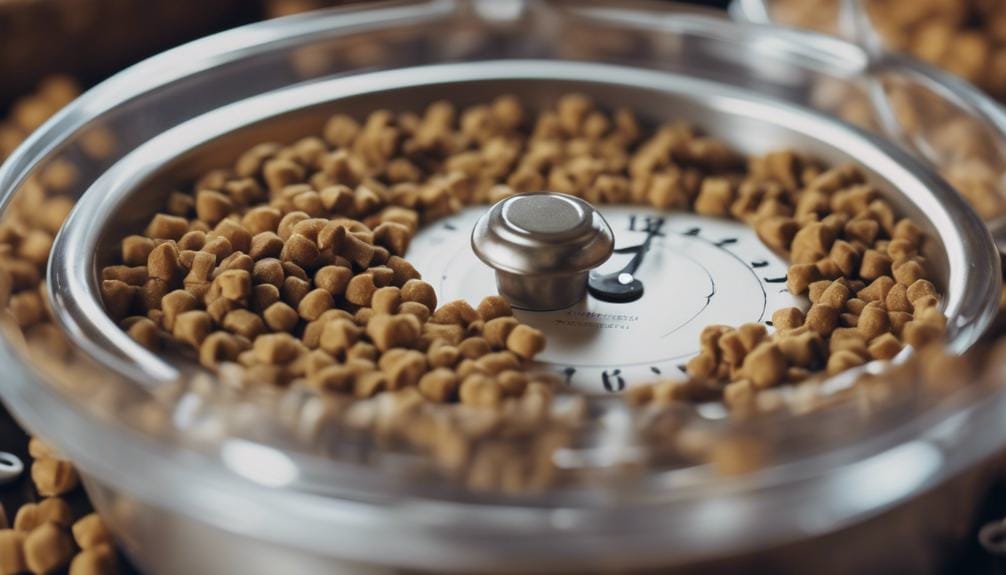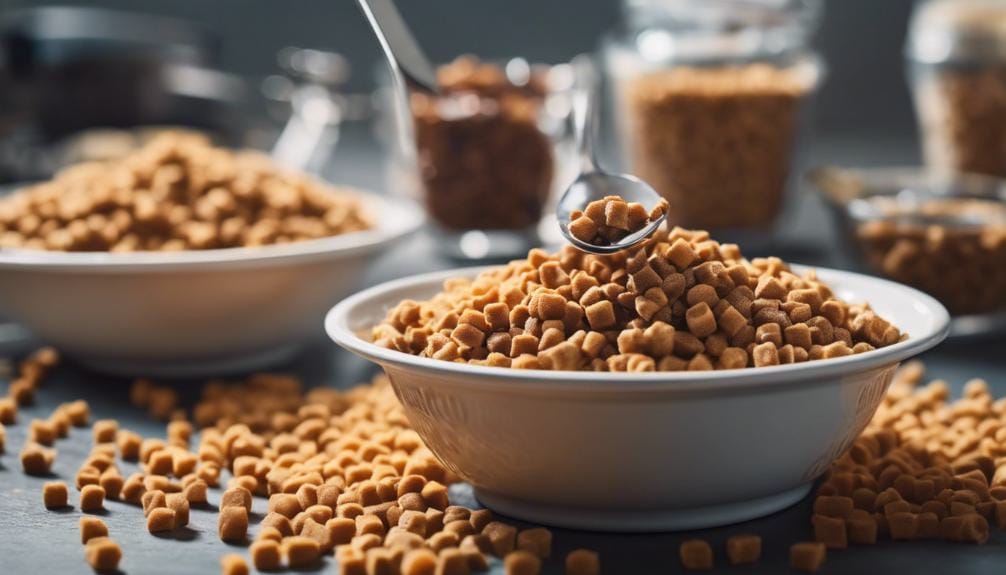Feeding a puppy without a bottle may seem like a challenging task, but rest assured, it can be done with the right approach. By utilizing alternative feeding methods such as a syringe or spoon, you can provide your furry friend with the nourishment they need to thrive.
However, there are important steps to think about beyond just the feeding process. Stay tuned to discover key tips on ensuring your puppy’s nutritional needs are met and how to make the change to solid foods seamless for their growth and well-being.
Key Takeaways
- Use a small syringe or dropper for controlled feeding.
- Hold the puppy gently at an angle to aid swallowing.
- Offer small amounts of formula to prevent choking.
- Monitor feeding progress closely and adjust as needed.
Choosing the Right Puppy Food
When selecting the right puppy food, consider your puppy’s specific needs based on factors like age, size, breed, and any existing health conditions. Puppies have different nutritional requirements compared to adult dogs, so it’s important to choose a puppy food that’s labeled as ‘complete and balanced.’ This guarantees that the food contains all the essential nutrients your growing pup needs to thrive. Look for high-quality, meat-based puppy foods as they’re rich in protein, which is essential for your puppy’s development.
Considering your puppy’s age, size, and breed is important when selecting food. Large breed puppies have different dietary needs compared to small breed puppies, so choosing a formula specifically designed for your puppy’s size is beneficial. Additionally, certain breeds may have sensitivities or predispositions to certain health conditions, so taking these factors into account can help you make a more informed decision.
It’s recommended to opt for puppy foods that are certified by the AAFCO (Association of American Feed Control Officials). This certification guarantees that the food meets the minimum nutritional requirements for puppies. Consulting with a veterinarian can also provide you with personalized recommendations tailored to your puppy’s specific needs. Your vet can help you navigate any health conditions or dietary concerns your puppy may have, ensuring that you’re providing them with the best possible nutrition for their growth and development.
Establishing a Feeding Schedule

To establish a feeding schedule for your puppy, consistency in meal times is key to regulating their feeding habits effectively. Newborn puppies require structured feeding routines to support their growth and development without the need for a bottle.
Here are some essential tips to help you establish a successful feeding schedule for your puppy:
- Set Meal Times: Establish specific meal times for your puppy and stick to them each day. Consistency will help your puppy learn when to expect food, creating a routine that regulates their eating habits.
- Monitor Portion Sizes: Be mindful of the portion sizes you offer your puppy. Avoid overfeeding or underfeeding by following recommended guidelines based on your puppy’s age and breed.
- Balanced Diet: Provide a balanced diet tailored to meet the nutritional needs of your puppy. Make sure that the food you offer contains essential nutrients that support healthy growth and development.
- Show Enthusiasm: Encourage your puppy to eat by displaying enthusiasm during meal times. Your positive attitude can influence your puppy’s behavior and make feeding a more enjoyable experience.
- Use Positive Reinforcement: Use positive reinforcement techniques to reward your puppy for good eating habits. Praise and treats can help reinforce positive behavior and create a positive association with meal times.
Introducing Solid Foods to Your Puppy

Introducing solid foods to your puppy begins by moistening dry puppy food with warm water to create a soft consistency for easy consumption. It’s crucial to make sure the food is soft enough to be gentle on your puppy’s developing digestive system. Here is a helpful guide to assist you in shifting your puppy to solid food:
| Key Steps | Details |
|---|---|
| Moistening Dry Puppy Food | Start by adding warm water to dry puppy food, allowing it to soften before offering to your puppy. |
| Gradual Shift | Reduce the amount of water added gradually to help your puppy adjust to the solid food texture. |
| Monitoring Your Puppy’s Response | Keep a close eye on how your puppy responds to the solid food, adjusting the texture as needed. |
| Feeding Schedule | Offer small, frequent meals of softened dry food to encourage a successful shift to solid food. |
Monitoring Your Puppy’s Growth
To properly monitor your puppy’s growth, begin tracking their weight daily for the first few weeks of their life. Keeping a close eye on their weight is essential to ensuring they’re developing as they should.
Here are some key points to take into account:
- Record Weight Gain: Keep a record of your puppy’s weight gain to make sure they’re growing at a healthy rate.
- Monitor Daily Gain: Look for a steady weight gain of around 5% of their body weight daily during the initial weeks.
- Check for Signs of Issues: Be vigilant for signs of malnutrition or dehydration by observing your puppy’s overall appearance and behavior.
- Assess Growth Milestones: Regularly assess important growth milestones like eye opening and teeth eruption to track your puppy’s development.
- Seek Veterinary Advice: If you notice any concerning changes in your puppy’s weight, behavior, or development, consult your vet promptly to address any potential issues.
Tips for Successful Feeding

For successful feeding of your puppy, make sure you use a small syringe or dropper with a soft, small tip to prevent any injuries during the process. When feeding the puppy, offer small amounts of formula at a time to prevent choking or aspiration. Hold the puppy securely but gently, making certain they’re at a slight angle to aid in swallowing the formula effectively.
Remember to monitor the puppy’s feeding progress closely to guarantee an adequate intake of formula. This monitoring will also help prevent spillage and allow you to adjust the feeding method if necessary. It’s vital to maintain secure handling of the syringe or dropper throughout the feeding process to avoid any accidents or spills.
As the feeding progresses, observe how the puppy responds to the feeding method. If the puppy seems uncomfortable or is struggling to swallow the formula, consider adjusting the feeding angle or the amount of formula given at a time. By staying attentive and responsive to the puppy’s cues, you can make sure a successful feeding experience for your furry companion.
Frequently Asked Questions
What Can I Feed a Newborn Puppy if I Don’t Have Formula?
If you don’t have formula, feed a newborn puppy homemade options like whole milk, egg yolk, yogurt, or a mix of boiled water, evaporated milk, and sugar as a temporary solution. Consult a vet promptly for proper guidance.
How Do You Manually Feed a Puppy?
To manually feed a puppy, gently insert a small syringe or eyedropper into the corner of its mouth. Slowly dispense milk replacer or formula, ensuring the puppy swallows properly. Watch for signs of choking and aim for a safe feeding process.
Do You Have to Bottle Feed Puppies?
You don’t have to bottle feed puppies if they can lap up liquid. Use a shallow dish for feeding if they can lap effectively. This method helps them learn to eat independently, moving to solid food gradually.
How Do You Feed a Newborn Puppy Without a Syringe?
To feed a newborn puppy without a syringe, use a clean cloth to stimulate elimination after each feeding. Gently apply milk replacer on the cloth and rub the genital and anal area. Assure warmth and moisture for comfort and mimicry.
Conclusion
To guarantee feeding a puppy without a bottle requires patience, consistency, and attention to their nutritional needs.
By choosing the right puppy food, establishing a feeding schedule, introducing solid foods gradually, monitoring their growth, and following feeding tips, you can guarantee your puppy grows up healthy and strong.
Remember to consult with a veterinarian for guidance and support throughout the feeding process.
With proper care and attention, your puppy will thrive and develop into a happy, healthy adult dog.





Leave a Reply
You must be logged in to post a comment.